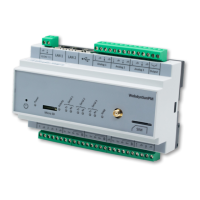contact@webdyn.com | webdyn.com
V2.05 subject to changes | Webdyn © by Flexitron Group
3.1.1 Operating Principle
Conguration is based on a directory tree structure and les on an FTP, SFTP or WebDAV server.
By default, the concentrator identier (uid) is calculated using the product MAC address, taking its last 6
characters prexed by “WPM”. Thus, for a product with a MAC dress of “00:8D:00:00:BD:E4, the default
uid will be “WPM00BDE4.
This uid is then used to prex all the conguration les uploaded to the server. This is why it is essential
for the uid to be unique for the entire installation.
The les are broken down as follows:
• Concentrator conguration les: these are les that contain data specic to the concentrator.
By default they are stored in the “/CONFIG” directory on the server.
• Device denition les: the les used to congure/manage the different devices connected to
the concentrator. By default they are stored in the “/DEF” directory on the server.
Please note that the concentrator does not create a congured tree structure. Therefore, all the congured
directories need to be created manually. Thus, by default, the following directories at least should exist
on the server:
• /CONFIG
• /ALARM
• /LOG
• /BIN
• /CERT
• /DATA
• /CMD
• /DEF
• /SCRIPT
These directories should have read-write rights for the congured user. (See section4.1 : “The FTP/SFTP
/WebDAV server”) for more details on the required access rights.
2 separate servers can be congured. Both servers are used to upload data and backup the conguration.
Server 1 is called the main server, server 2 the secondary server.
If les are modied on the server, only the les on the main server are taken into account. Therefore,
there are no risks of conicts if the conguration les are modied on both servers.
Modications made on the main server are propagated to the secondary server at the next connection.
3.1.2 Conguration Files
There are several types of conguration le.
There are les to congure concentrator operation (connection to the server, NTP management,
passwords, modem, etc.) as well as connected device denition les.

